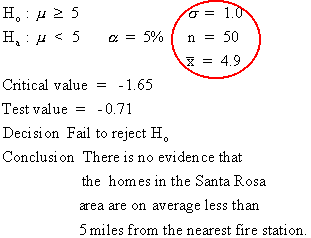Seeing is believing!
Before you order, simply sign up for a free user account and in seconds you'll be experiencing the best in CFA exam preparation.
Basic Question 5 of 8
The Santa Rosa Homeowners are trying to prove that the homes in their area are less than 5 miles from the nearest fire station. The data and hypothesis test is shown below. A Type II error could have been made; a discussion of this error would involve ______.
B. concluding that the homes in the Santa Rosa area are, on average, less than 5 miles from the nearest fire station when in fact the homes are, on average, 5 or more miles from the nearest fire station.
C. going along with the conclusion that the homes in the Santa Rosa area are, on average, 5 or more miles from the nearest fire station when in fact the homes are, on average, less than 5 miles from the nearest fire station.

A. concluding that the homes in the Santa Rosa area are, on average 5, or more miles from the nearest fire station when in fact the homes are, on average, less than 5 miles from the nearest fire station.
B. concluding that the homes in the Santa Rosa area are, on average, less than 5 miles from the nearest fire station when in fact the homes are, on average, 5 or more miles from the nearest fire station.
C. going along with the conclusion that the homes in the Santa Rosa area are, on average, 5 or more miles from the nearest fire station when in fact the homes are, on average, less than 5 miles from the nearest fire station.
User Contributed Comments 9
| User | Comment |
|---|---|
| tanyak | why not A.? Because it says "concluding" as opposed to "going along"? |
| surob | As it was mentioned in previous questions, Type I - concluding, Type II - going along are key words |
| dhiru | I think because type-I error means you are actually rejecting a hypothesis ....it has to imply that you are concluding (taking a firm stand) in order to reject it as opposed to type-II where you are not rejecting (not doing any action) ....which has to imply that you are assuming or "going along" |
| bdaguy | "Concluding" implies that you have made an actionable decision in rejecting the null hypothesis. This is an important aspect of hypothesis testing and Type I errors since there is an implication for having made a wrong decision. "Going along" implies that the null hypothesis is plausible but nothing has been ruled out and, therefore, no decisions were made or actions taken. In other words, it's better to do nothing when you don't have a reason to act (Type II error) than to make a decision based on a faulty conclusion (Type I error). |
| mordja | Type two error is accepting (failing to reject, "going along with") the null hypothesis when it is false. Therefore it has to be c. If you are accepting the null when it is false then the null above states that population mean is greater than or equal to five. thus answer is C. |
| johntan1979 | I think it's wise to not waste other people's time by asking a question that has already been covered in previous questions. |
| gill15 | Fail to reject --- you are not doing anything --- your going along for the ride like john said...this has been discussed in depth before |
| davcer | Conclusion: "there is no evidence" thus C is correct |
| Rachelle3 | When you FAIL to forbid what is actually FALSE that's Type2 "4 f sake you , you Fell For the Fake or lie again!" - this is how I remember the difference. I am not having a go at anyone but if you know this sentence you will always know Type 2 from Type 1 I hope this helps and does not get me in trouble! = > |

I used your notes and passed ... highly recommended!

Lauren
Learning Outcome Statements
explain hypothesis testing and its components, including statistical significance, Type I and Type II errors, and the power of a test
CFA® 2025 Level I Curriculum, Volume 1, Module 8.